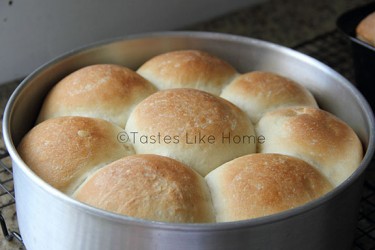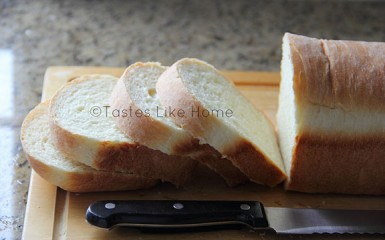Hi Everyone,
It’s been nice sharing with you about the meet-up in Fort Lauderdale with Al, CAG and Observer, along with their wives Mar, Desi and Pat. However, just like how that weekend had to come to an end, so too must this series.
This week concludes the Fort Lauderdale Soirée series, and we end right were we began the weekend – in the home of Al and Mar.
Mar was the only Jamaican among us Guyanese but she fit right in. Our welcome dinner was a Jamaican feast and so it seems only fitting that we conclude with a Jamaican favourite in which we all part-took: hard-dough bread.

And on another occasion, slathered with butter and downed with a big cup of sweet milky tea.
The meat of the 10-plus-pound, whole, baked red snapper would have gone down well between two slices of bread “buttered” with Mayonnaise – Observer would have loved that. The man is obsessed with mayonnaise and eats it with almost everything.
A thick-cut slice of hard-dough bread could have taken the weight of the ackee and salt fish that was cooked with cubed salted pork but we had boiled yellow yam, green bananas and dumplings instead. You left too early CAG!
Hard-dough Bread
Just as how each country has its own bread-rolls (salt bread, tennis roll etc), they also have their own loaf that is a household favourite. While in Guyana we have the plait bread, in Jamaica it’s hard-dough bread.

Hard-dough bread is so-called because of the heft and density of the bread. The dough is mixed with cold water instead of the traditional warm water that most bread recipes call for. While the warm water helps to activate the yeast and start the fermenting and proofing process quickly, using cold water slows down the process.
The kneading time for hard-dough bread goes beyond what is normally suggested; instead of kneading the dough for 10 minutes, hard-dough bread requires that it be kneaded for 15 – 20 minutes. This prolonged working of the dough ensures a tighter crumb and a firmer loaf as a result of the worked gluten in the flour.
Another thing that sets the hard-dough bread apart is the proofing time. The first resting time is a mere 40 minutes and the second rise (after the dough has been shaped and placed in the pans) is also 40 minutes. Regular white loafs require as much as 1½ – 2

hours for the first rise depending on the temperature of the environment and then as much as 1 hour for the second proofing. Given the time difference, it makes making hard-dough bread much more appealing.
The short set of proofing/rising time means that the dough will not grow so much and become airy, rather it will expand but with some degree of denseness. When baked it results in a meaty bread. It is the kind of bread that when you cut and eat a slice and you would feel completely satisfied; it is truly filling. Hard-dough bread is perfect for things like Pepperpot and sandwiches with heavy fillings such as meat. In other words, it can carry the weight of heavy fillings without becoming soggy or tearing easily.
If you do try the recipe, feel free to braid the dough or cut it and roll the pieces into balls creating rolls. Either which way, it’s all good!
Thanks again for the indulgence for the past 4 weeks and if you would like to meet up with the Food-Ins of Guyana, drop me a line at: Cynthia@tasteslikehome.org
Hard Dough Bread
(Adapted from The Real Taste of Jamaica)
Yield: 2 loaves
SPECIAL EQUIPMENT
● 2 (12 x 5) loaf pans
● 1 wire/cooling rack
● 1 pastry blender or 2 dining knives
INGREDIENTS
● 2 pounds all-purpose flour, plus extra for work surface
● 4 tablespoons granulated sugar (brown or white)
● 2 teaspoons fine table salt
● 2 teaspoons dried instant yeast
● 2 ounces cold unsalted butter
● 2 ½ – 3 cups cold water
● Vegetable oil
DIRECTIONS
1. Add the flour, sugar, salt and yeast to a large bowl and mix well.
2. Cut or rub in the butter to the flour mixture.
3. Add enough water to make a dough. When the dough comes together, turn on to a floured work surface and knead for 15 – 20 minutes or until dough is smooth.
4. Rub oil all over the dough and transfer to a large, oiled bowl. Cover with a clean, dry kitchen towel and let rise in a warm draft free place for 40 minutes.
5. Brush the 2 loaf pans with oil and set aside.
6. When the dough is ready (after the 40 minutes), turn it on to a work surface and cut evenly in half. Working with one piece of dough at a time, shape and roll it into a rectangle – 12 inches in width, the height does not matter.
7. Roll the dough as tightly as possible (along the width) and transfer to a loaf pan. Cover the pans loosely with a kitchen towel and let proof for 40 minutes.
8. 20 minutes after the dough has been proofing, preheat the oven to 375 degrees F (for the other 20 minutes).
9. At the end of the 40 minutes, transfer the pans to the oven and bake for 25 – 30 minutes or until the bread is browned at the top and sounds hallow when tapped.
10. Remove the pans from the oven, rest for 5 minutes and then turn out and place on wire rack to cool.
11. Serve warm or at room temperature.
NOTES
Cold water means water from the refrigerator or you can use a mixture of cold water from the fridge and tap water.
Use whatever loaf pans you have available, if you only have 9 x 5 loaf pans, make 3 loaves.
As I have said in the column, the dough can be shaped anyway you like – braided, swirled or rolled into balls. Whatever shaping you do, ensure that the dough is tightly molded.
The bread freezes well. To freeze – cool completely, wrap is wax or parchment paper then aluminum foil and place in freezer zip bag. To thaw, remove the bread from the zip bag and let naturally come up to room temperature.
Eid Mubarak to all celebrating and observing the festival of the sacrifice – Eid al-Adha. May we always strive to be as obedient and willing as Abraham to acquiesce to the will of God.





